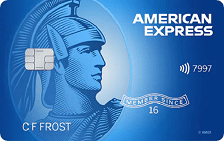Filter Options
×-
-
Unselect all
-
Unselect all
-
Unselect all

Showing 69 Cards
Sort By Column Name:
Chase Slate Edge℠

Chase Slate Edge℠
- 19.74% to 28.49% Variable Regular Purchase APR
- 19.74% to 28.49% Variable Balance Transfer APR
- 29.49% Variable Cash Advance APR
- 0% for the first 18 months from account opening date Intro Purchase APR
At a Glance
The Chase Slate Edge lets you make moves towards your credit goals with a host of impressive introductory bonuses. The card from Chase offers the chance at an automatic credit line increase, plus 0% intro APR for 18 months (with a variable APR after that) and automatic APR reduction when you pay on time after meeting minimum spending requirements– all for no annual fee.
- Best Benefits
- Rates & Fees
- Why Should You Apply?
- Start off strong with 0% Intro APR for 18 months from account opening on purchases and balance transfers. A variable APR of 20.49% - 29.24% on balance transfers and purchases after the introductory period ends.
- Lower your interest rate by 2% each year. Automatically be considered for an APR reduction when you pay on time, and spend at least $1000 on your card by your next account anniversary.
- Raise your credit limit. Get an automatic, one-time review for a higher credit limit when you pay on time, and spend $500 in your first six months.
- All for no annual fee - You won't have to pay an annual fee for all the great features that come with your Slate Edge℠ card
- Keep tabs on your credit health - Chase Credit Journey helps you monitor your credit with free access to your latest score, real-time alerts, and more
- Member FDIC
- Intro Purchase APR: 0% for the first 18 months from account opening date
- Regular Purchase APR: 19.74% to 28.49% Variable
- Intro Balance Transfer APR: 0% for the first 18 months from account opening date
- Balance Transfer APR: 19.74% to 28.49% Variable
- Balance Transfer Transaction Fee: Either $5 or 5% of the amount of each transfer, whichever is greater.
- Cash Advance APR: 29.49% Variable
- Cash Advance Transaction Fee: Either $10 or 5% of the amount of each transaction, whichever is greater
- Penalty APR: Up to 29.99% Variable
- Foreign Transaction Fee: 3% of the amount of each transaction in U.S. dollars
- You want to build credit with responsible usage
- You plan to carry a balance and will make use of the two 0% intro APR offers
- You don’t want to pay an annual fee
BankAmericard® Credit Card
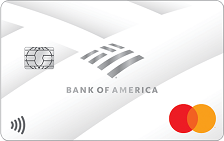
BankAmericard® Credit Card
- 16.24% to 26.24% variable based on creditworthiness and Prime Rate Regular Purchase APR
- 16.24% to 26.24% variable based on creditworthiness and Prime Rate Balance Transfer APR
- 19.24% to 29.24% variable based on the Prime Rate Cash Advance APR
- 0% for 18 months from account opening date Intro Purchase APR
At a Glance
The BankAmericard Mastercard is the balance transfer card designed for those who want a special intro rate and little else. The card features 0% intro APR on purchases and balance transfers for the first 18 months. The card also boasts no penalty APR and no annual fee.
- Best Benefits
- Rates & Fees
- Why Should You Apply?
- No interest charges on purchases and balance transfers for the first 18 months from the date of account opening
- No penalty APR for late payments
- No annual fee
- Access your FICO® Score for free
- Intro Purchase APR: 0% for 18 months from account opening date
- Regular Purchase APR: 16.24% to 26.24% variable based on creditworthiness and Prime Rate
- Intro Balance Transfer APR: 0% for 18 months for any balance transfers made within 60 days from account opening date
- Balance Transfer APR: 16.24% to 26.24% variable based on creditworthiness and Prime Rate
- Balance Transfer Transaction Fee: Either $10 or 3% of the amount of each transfer, whichever is greater
- Cash Advance APR: 19.24% to 29.24% variable based on the Prime Rate
- Cash Advance Transaction Fee: Either $10 or 5% of the amount of each transaction, whichever is greater
- Foreign Transaction Fee: 3% of the transaction amount in U.S. dollars
- Late Payment Penalty Fee: Up to $40
- Return Payment Penalty Fee: Up to $29
- You plan to make a large purchase and use the card to pay off the balance over time
- You have existing credit card balances to combine and pay down
- You don’t want to pay an annual fee
TD FlexPay
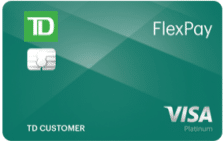
TD FlexPay
- 18.99%, 20.99%, 23.99%, 26.99% or 28.99% variable based on creditworthiness and the Prime Rate Regular Purchase APR
- 18.99%, 20.99%, 23.99%, 26.99% or 28.99% variable based on creditworthiness and the Prime Rate Balance Transfer APR
- 30.24% variable based on the Prime Rate Cash Advance APR
At a Glance
The TD FlexPay credit card is a balance transfer card with a difference. Beyond a lengthy intro APR on transfers, cardholders have the peace of mind that they can schedule which billing cycle in the future to skip a monthly payment each year with no penalty.
- Best Benefits
- Rates & Fees
- Why Should You Apply?
- Get TD Bank's best balance transfer offer
- Skip a Payment once a year with no penalty
- No annual fee
- No foreign transaction fees
- Visa Platinum credit card benefits and protections
- Regular Purchase APR: 18.99%, 20.99%, 23.99%, 26.99% or 28.99% variable based on creditworthiness and the Prime Rate
- Intro Balance Transfer APR: 0% Introductory APR for the first 18 billing cycles
- Balance Transfer APR: 18.99%, 20.99%, 23.99%, 26.99% or 28.99% variable based on creditworthiness and the Prime Rate
- Balance Transfer Transaction Fee: Intro fee of either $5 or 3% of the amount of each transfer, whichever is greater, on transfers made within the first 18 billing cycles after Account opening referenced in the offer above After that: Either $5 or 5% of the amount of each transfer, whichever is greater.
- Cash Advance APR: 30.24% variable based on the Prime Rate
- Cash Advance Transaction Fee: Either $10 or 5% of the amount of each cash advance, whichever is greater.
- Late Payment Penalty Fee: Up to $40, first late payment fee refunded every 12 billing cycles.
- Return Payment Penalty Fee: Up to $39
- Minimum Deposit Required: N/A
- You want a balance transfer credit card that works around your needs
- You can be forgetful and want a card that understands nobody is perfect
- You plan to use the card for foreign trips or vacations
- You don't want to pay an annual fee
Citi® Diamond Preferred® Card
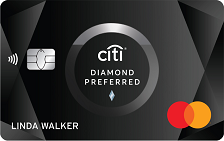
Citi® Diamond Preferred® Card
- 17.99% - 28.74% (Variable) Regular Purchase APR
- 17.99% - 28.74% (Variable) Balance Transfer APR
- 29.99% (Variable) Cash Advance APR
- 0% for 12 months on Purchases Intro Purchase APR
At a Glance
The Citi® Diamond Preferred® Card provides one of the longest 0% intro APR periods on the market for no annual fee.
- Best Benefits
- Rates & Fees
- Why Should You Apply?
- 0% Intro APR for 21 months on balance transfers from date of first transfer and 0% Intro APR for 12 months on purchases from date of account opening. After that the variable APR will be 17.99% - 28.74%, based on your creditworthiness. Balance transfers must be completed within 4 months of account opening.
- There is a balance transfer fee of either $5 or 5% of the amount of each transfer, whichever is greater
- Get free access to your FICO® Score online.
- With Citi Entertainment®, get special access to purchase tickets to thousands of events, including concerts, sporting events, dining experiences and more.
- Intro Purchase APR: 0% for 12 months on Purchases
- Regular Purchase APR: 17.99% - 28.74% (Variable)
- Intro Balance Transfer APR: 0% for 21 months on Balance Transfers
- Balance Transfer APR: 17.99% - 28.74% (Variable)
- Balance Transfer Transaction Fee: 5% of each balance transfer; $5 minimum.
- Cash Advance APR: 29.99% (Variable)
- Cash Advance Transaction Fee: 5% of each cash advance; $10 minimum
- Penalty APR: Up to 29.99% (Variable)
- Annual Fee: $0
- Foreign Transaction Fee: 3%
- Late Payment Penalty Fee: Up to $41
- Return Payment Penalty Fee: Up to $41
- You make frequent purchases to entertainment events and want priority access
- You're looking for a generous introductory 0% APR period for both purchases and balance transfers
Citi Simplicity® Card
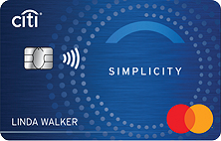
Citi Simplicity® Card
- 18.99% - 29.74% (Variable) Regular Purchase APR
- 18.99% - 29.74% (Variable) Balance Transfer APR
- 29.99% (Variable) Cash Advance APR
- 0% for 12 months on Purchases Intro Purchase APR
At a Glance
The Citi Simplicity® Card is one of the most consumer-friendly balance transfer cards available today, 0% intro APR on balance transfers for 21 months from the date of first transfer as well as 0% intro APR for 12 months on purchases from when the account opens.
- Best Benefits
- Rates & Fees
- Why Should You Apply?
- No Late Fees, No Penalty Rate, and No Annual Fee... Ever
- 0% Intro APR for 21 months on balance transfers from date of first transfer and 0% Intro APR for 12 months on purchases from date of account opening. After that the variable APR will be 18.99% - 29.74%, based on your creditworthiness. Balance transfers must be completed within 4 months of account opening.
- There is an introductory balance transfer fee of $5 or 3% of the amount of the transfer, whichever is greater for balances transfers completed within 4 months of account opening.
- Stay protected with Citi® Quick Lock
- Intro Purchase APR: 0% for 12 months on Purchases
- Regular Purchase APR: 18.99% - 29.74% (Variable)
- Intro Balance Transfer APR: 0% for 21 months on Balance Transfers
- Balance Transfer APR: 18.99% - 29.74% (Variable)
- Balance Transfer Transaction Fee: There is an intro balance transfer fee of 3% of each transfer (minimum $5) completed within the first 4 months of account opening. After that, 5% of each balance transfer; $5 minimum.
- Cash Advance APR: 29.99% (Variable)
- Cash Advance Transaction Fee: 5% of each cash advance; $10 minimum
- Annual Fee: $0
- Foreign Transaction Fee: 3%
- Late Payment Penalty Fee: No Late Fee
- Return Payment Penalty Fee: Up to $41
- You have a significant balance elsewhere that you’d like to transfer over and pay off without interest
- You enjoy the freedom of having 12 months with 0% introductory APR on the purchases made with this card
- You want a credit card with robust consumer protection features
You've viewed 5 of 69 credit cards
What Is a Balance Transfer?
A balance transfer is a financial transaction that involves transferring debt from one credit card account to another.
Why Choose a Balance Transfer Credit Card?
If you’re struggling with high-interest credit card debt, balance transfer credit cards can be a game-changer. These financial tools allow you to consolidate your debt onto a single card with a lower interest rate, saving you money and simplifying your finances.
Balance transfer credit cards allow cardholders to consolidate their credit card debt from multiple cards onto one card. This strategy is popular for managing debt because it can potentially reduce overall costs by having all the debt in one place.
Benefits of a Balance Transfer Card
Balance transfer credit cards offer a host of benefits that can help you manage your debt and improve your financial situation. These cards are a great alternative to personal loans, as they can help you avoid origination costs. Additionally, they may offer extra benefits such as cash back, points, or a 0% introductory APR for up to 21 months on purchases.
Many of the best balance transfer credit cards offer features that simplify payments and save money. When applying for a balance transfer card, look for perks like:
- Extended 0% introductory APR periods
- Low or fixed interest rates
- Waived or reduced balance transfer fees
- No annual fee
Because balance transfer credit cards have lengthy introductory APR periods and below-average interest rates afterward, they are intended for consumers with very good or excellent credit scores. Typically, a FICO Score of 670 or higher is required to get approved for a balance transfer credit card, although the specific qualifications may vary by bank.
How Does the Balance Transfer Process Work?
Transferring your balance to a new credit card may seem daunting, but it’s actually a straightforward process. Here’s a step-by-step guide to help you navigate the balance transfer process smoothly:
- Evaluate your current credit card debt: Look closely at your current balance, interest rates, and terms. This will give you a clear understanding of how much you need to transfer and which cards are the best candidates for a balance transfer.
- Apply for the new credit card: Once you’ve identified the best balance transfer credit card for your needs, complete the application process. Make sure to provide accurate information and review the terms and conditions carefully.
- Wait for approval: After submitting your application, the credit card issuer will review your information and decide. This process may take a few days, so be patient.
- Notify your existing credit card issuer: Once you’ve been approved for the new credit card, contact your existing credit card issuer to request a balance transfer. Provide them with the necessary information, such as the new credit card details and the amount you wish to transfer.
- Monitor the transfer process: Monitor both your old and new credit card accounts to ensure that the balance transfer is completed successfully. It may take a few days for the transfer to be processed, so be patient.
- Start making payments: Once the balance transfer is complete, start making payments on your new credit card. Take advantage of the low or 0% APR introductory period to pay down your debt efficiently.
Balance Transfer or Personal Loan: Which Is Right for You?
Balance transfers and personal loans may seem similar, as they both involve opening a new line of credit at a lower interest rate and using it to pay off higher-interest debt. However, there are some important differences to consider. Here are the pros and cons of both options:
Balance Transfer
Pros:
- 0% Intro APR Offers
- Flexible Payments
- Could potentially improve your credit score or demonstrate a positive credit history
- Competitive Interest Rates
Cons:
- Balance transfer fees may apply
- Approval based on credit score
- Late or missed payments can have a negative impact on your credit
- Can only be used for existing credit card debt
Personal Loan
Pros:
- Fixed Rates/Lower Rates
- Installment Payments
- Approval based on credit score and DTI (debt-to-income ratio)
Cons:
- Approval based on credit score and DTI
- Additional loan origination fees may apply
- Late or missed payments can hurt your credit
- May require collateral if applying for a secured personal loan
Tips for Managing Balance Transfer Cards
While balance transfer credit cards can be powerful tools for saving money and simplifying your finances, using them responsibly is important. Here are some tips to help you effectively manage your balance transfer credit card:
- Create a repayment plan: Develop a clear repayment plan that outlines how much you will pay each month and when you aim to become debt-free. Stick to this plan and avoid making unnecessary purchases or additional debt.
- Pay on time: Late payments can result in penalties, fees, and potential damage to your credit score. Set up automatic payments or reminders to ensure you never miss a due date.
- Avoid new charges: While paying down your transferred balance, refrain from using your balance transfer credit card for new purchases. Focus on eliminating your existing debt before taking on additional financial obligations.
- Monitor your credit score: Regularly check your credit score to track your progress and ensure that your financial habits positively impact your creditworthiness.
- Resist the temptation of more debt: With a lower interest rate and an available credit limit, it can be tempting to take on more debt. However, remember that the goal is to become debt-free, so exercise discipline and avoid unnecessary spending.
Common Mistakes to Avoid
While balance transfer credit cards can be incredibly beneficial, there are also some common mistakes that you should avoid, if possible:
- Ignoring the fine print: Before applying for a balance transfer credit card, carefully read the terms and conditions. Understand the introductory period length, regular APR, balance transfer fees, and any other charges that may apply.
- Missing payments: Late payments can result in the loss of your promotional APR and trigger penalty fees. Always make payments on time and set up reminders to avoid any mishaps.
- Overspending: The availability of a new credit limit can be tempting, but remember that the goal is to pay down your debt. Avoid making unnecessary purchases and stay focused on your repayment plan.
- Closing old credit card accounts: While it may be tempting to close your old credit card accounts after transferring the balance, it’s generally better to keep them open. Closing accounts can negatively impact your credit score, so consider keeping them active with minimal usage.
- Applying for multiple credit cards: Opening multiple balance transfer credit cards can be overwhelming and potentially harmful to your credit score. Stick to one or two cards and focus on paying off your debt efficiently.
FAQs
Balance transfers can seem confusing – but they don’t have to be. Here are some of the most commonly asked questions about balance transfers and balance transfer credit cards:
What is a balance transfer?
- A balance transfer is a process of taking an existing credit card balance and moving it to a new account with a lower regular APR. These transfers make it easier to pay down balances and often come with intro APR offers.
Who can qualify for a balance transfer card?
- Because these types of cards offer low-interest rates, a good credit score is a minimum requirement for a balance transfer card. Many issuers require an excellent credit score, so a good benchmark for obtaining a card like these is a FICO Score of 700 or higher.
What are the downsides to a balance transfer?
- Because these cards feature an introductory rate, you might find yourself stuck with more debt than you began. After the promotional period ends, only those with the best credit scores will have the lowest rates. Those with good credit might be paying a higher APR – primarily if they conduct their transfer using a rewards credit card. Other negatives of transferring a balance include:
- Increasing credit utilization on a single card, which can lower your credit score.
- Lowering the average age of your credit accounts by opening a new line of credit.
- A new line of credit also means a further hard inquiry, which can also impact your credit score.
Do all balance transfer cards come with 0% intro APR?
- While many cards feature 0% intro AR, not all balance transfer cards provide an interest-free period, some cards – especially those from credit unions or smaller banks – may only offer a reduced interest rate. These rates maybe 3.99% or higher, but are often significantly lower than the standard variable APR.
Do all card issuers offer a balance transfer card?
- While most major card issuers provide a variety of offers, not all currently offer a balance transfer credit card. Most significant issuers and banks, like Chase (Chase Slate Card), Citi (the Citi Simplicity Card), and others, provide balance transfer cards and low APR Cards. Discover also reintroduced its balance transfer card, the Discover It Balance Transfer.
What is the average interest rate on a balance transfer card?
- According to the BestCards guide to the average APR for all types of credit cards, the current average interest rate for a balance transfer card is approximately 16.99%.
Do rewards cards make good balance transfer cards?
- In some cases, yes. Some cash back cards, like the Citi Double Cash Card, offer 0% APR on balance transfers and cash back rewards program in one package. Just be sure to pay your statement balance in full before the due date, or you might incur a late fee or penalty APR.
What is the minimum payment due on a balance transfer credit card?
- The minimum payment on a balance transfer credit card is typically 1% to 3% of the total balance on the card, depending on the bank that issues the card.
Can you transfer a balance to a bank account?
- No, but you can use the bank account, cash app, or PayPal to pay off the balance.
Can you get cash from a balance transfer credit card?
- Yes, you can get cash from your balance transfer credit card, though this would be a cash advance and would result in instant interest and a cash advance fee.
Can you transfer a negative balance / remaining credit card balance to a debit card, bank account, mobile wallet, or another service?
- You can use a credit card to transfer money into a bank account by using a cash advance or balance transfer check, but this isn’t advisable. Once a cash advance is conducted (banks typically let cardholders take out around 25% of their credit limit), you can then send that money from your bank account to wherever you like. Cash advances are risky due to the high interest rates and costly one-time fees.
Can you transfer money from a bank account, e-wallet, PayPal, Cash app, or Venmo to a credit card?
- In some instances, yes. Of course, when you transfer money from a bank account to a credit card, you are effectively just paying the credit card statement and lowering your overall balance. With wallets and PayPal/Venmo, carefully read your card member agreement. This document will outline the various ways to redeem PayPal cash back to card accounts. PayPal charges 2.9% of the amount, plus a fixed fee of 30 cents, to process a person-to-person money transfer using a credit card.
Can I transfer money from my credit card to someone else’s balance?
Yes, via a cash advance and wire transfer. This simple process involves cash advance fees, high APR, and potential money wire fees.
Conclusion
Balance transfer credit cards can be powerful tools for anyone looking to save money on high-interest credit card debt and simplify their finances. By taking advantage of low or 0% introductory APRs and consolidating your balances onto a single card, you can make significant progress in becoming debt-free.
Remember to choose a balance transfer credit card that suits your needs, develop a repayment plan, and manage your card responsibly. By following the tips and avoiding common mistakes, you can leverage these financial tools to your advantage and achieve financial freedom.
Check out more
Balance Transfer Credit Cards
Editorial Disclosure – The opinions expressed on BestCards.com's reviews, articles, and all other content on or relating to the website are solely those of the content’s author(s). These opinions do not reflect those of any card issuer or financial institution, and editorial content on our site has not been reviewed or approved by these entities unless noted otherwise. Further, BestCards.com lists credit card offers that are frequently updated with information believed to be accurate to the best of our team's knowledge. However, please review the information provided directly by the credit card issuer or related financial institution for full details.



